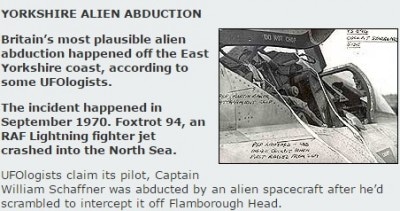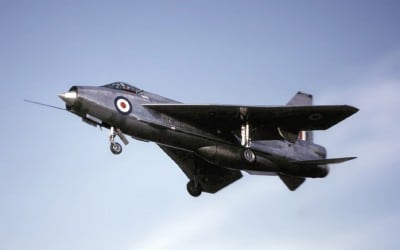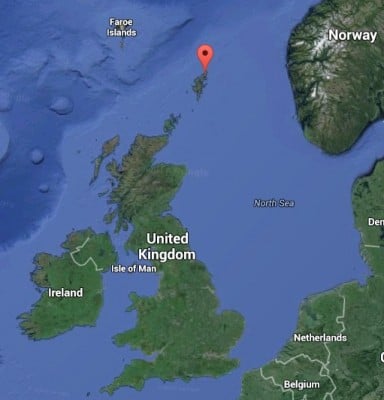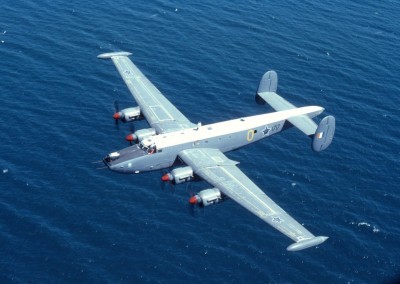The Mysterious Disappearance of Foxtrot 94
This is one of my favourite aviation mysteries, in which a military pilot is reported as chasing after an unidentified object in the sky which he describes as glowing in a golden light before disappearing completely. His aircraft was found at the bottom of the lake, with the canopy shut and no trace of the pilot. A favourite of UFO aficionados, here’s the whole story.
RAF Binbrook in north-east Lincolnshire, England, was originally a Bomber Command station during World War II. The Royal Air Force No 12 Squadron was stationed there until 1942, when they moved to RAF Wickenby. After this, the 64 Squadron’s Gloster Javelin (an all-weather fighter) was hosted there. RAF Binbrook also served as the base for the last two RAF squadrons to employ the English Electric Lightning.
The No 5 Army Co-operation Squadron of the Royal Flying Corps was formed in 1913. It was disbanded repeatedly but in 1959, it was restored as a night fighter squadron at RAF Laarbruch in Germany. In 1965, they took their English Electric Lightnings and moved to RAF Binbrook.
The Lightning is an all-British Mach 2 fighter aircraft, developed and manufactured by English Electric. It was the RAF’s primary interceptor for over twenty years and pilots described flying it as “being saddled to a skyrocket.” The aircraft was retired in the late 1980s.
Captain William Schaffner was born on September 11 in 1941. He was a pilot in the United States Airforce. He was stationed in the UK as an American exchange pilot, flying Lightnings with 5 Squadron out of RAF Binbrook. His callsign was Foxtrot 94.
In 1970, the country was in the grip of the Cold War and tensions were high. Russian aircraft were regularly flying into the North Atlantic to test the reaction from NATO fighters. RAF Saxa Vord was a vital part of Britain’s air defence during this period, giving first warnings of Soviet bombers entering UK airspace. The radar station was the most northerly military base situated in the Shetland Isles north of Scotland, on the island of Unst. The island of Unst is further north than Leningrad and on the same latitude as Anchorage, Alaska.
Saxa Vord is the name of the hill where the station is located. At 935 feet (285 metres) it is highest hill on Unst. Saxa Vord’s modern claim to fame is that it holds the unofficial British record for highest wind speed: in 1992 the wind was recorded at 197 mph (317 km/h) just before the measuring equipment blew away.
And here’s where the story starts. It goes something like this…
At 20:17 on the 8th of September 1970, a radar operator at Saxa Vord spotted an unidentified aircraft over the North Sea between the Shetlands and Norway. This required a response from the RAF station on Quick Action Alert, the 24-hour Royal Air Force air defence maintained by NATO.
RAF stations on Quick Action Alert have pilots on duty who are fully dressed and ready in the Aircrew Ready Room, which is next to hangars housing interceptor aircraft. The duty shift is around twenty hours and each pilot is on shift once or twice a month.
The current RAF stations on Quick Reaction Alert are RAF Coningsby and RAF Lossiemouth with two Eurofighter Typhoons loaded and ready to go.
At the time the Quick Action Alert stations were RAF Coningsby and RAF Binbrook. Captain William Schaffner was on duty at RAF Binbrook.
So the radar operator reported the unidentified target. Two Lightnings were immediately scrambled from RAF Leuchers on the east coast of Scotland.
The radar target was tracked by the early warning station at RAF Fylingdales in the North York Moors in England, the US Air Force radar station at Thule Air Base in Greenland and the Cheyenne Mountain Complex radar base in Colorado Springs, Colorado in the US.
The Lightnings were asked to return to base and two American F4 Phantoms with more sophisticated radar equipment were scrambled from Keflavik in Iceland to patrol the area. However, the target had been lost.
Just over an hour later at 21:30, the target was picked up again on radar heading south-west over the north end of Denmark. Two Lightning interceptors were again scrambled from RAF Leuchars to patrol to the north-east of Aberdeen. Another two Lightnings were scrambled from RAF Coltishall.
RAF Staxton Wold in North Yorkshire tracked the object flying east of Whitby and parallel to the English coast.
Captain Schaffner is said to have been pacing in the Aircrew Ready Room, waiting for his orders to intercept. The Lightning was armed with two Red Top air-to-air missiles.
Finally, he was called. He boarded the aircraft while they were still filling the fuel tanks. At 22:06, Captain Schaffner took off from Binbrook in the Lightning XS894.
A transcript was published by the Grimsby Evening Telegraph who claimed that that an anonymous source had said that it was the official transcript. It includes Captain Schaffner telling the radar station at Staxton Wold that he’d made visual contact with the unidentified aircraft.
SCHAFFNER: Affirmative it’s not actually connected…maybe magnetic attraction to The conical shape. There’s a haze of light ye’ow …it’s within that haze. Wait a second it’s turning…coming straight for me… I’m taking evasive action…a few…I can hardly…
And that’s the last anyone knew.
Search and rescue scoured the area the following morning but were unable to find any trace of the Lightning or the pilot.
It was almost two months later when Royal Navy divers found the aircraft. The Lightning was recovered from the sea bed three months later. It was mostly undamaged and the cockpit canopy was shut. There was no sign of Captain Schaffner.
The wreckage was returned to RAF Binbrook for investigation. It’s likely that this was handled at the MOD Crash Investigation Branch, part of the Royal Aircraft Establishment (now the Air Accidents Investigation Branch) at Farnborough.
There was an official inquiry into the crash but the results were not made public. The Captain’s two sons wanted to understand how their father had disappeared but were told that the reports on the crash had been shredded.
The mystery gained traction and many believed that Captain Schaffner had been abducted by aliens, even though the transcript as published did not actually bear much resemblance to standard radio exchanges of the time and no source or reference was ever given for this supposed official transcript.
In 2002, after pressure from the BBC, The Ministry of Defence released the secret documents and classified photographs related to the accident. This included a copy of the inquiry report, the actual transcript of the Captain’s final conversation with ground controllers and photographs showing the Lightning’s empty cockpit.
The documents make it clear that the radar target was not unknown at all: it was a slow-moving Shackleton reconnaissance aircraft. The Avro Shackleton was a British long-range maritime patrol aircraft used by the Royal Air Force. The incident was not a real incursion of airspace but an exercise to practice shadowing low-flying targets at night. Captain Schaffner was meant to intercept it.
The inquiry discovered that Captain Schaffner had not been properly trained to carry out the exercise he’d been asked to undertake.
Air Clues, the UK Royal Air Force Flight Safety Magazine, published an article on the crash which explained more about the Captain Schaffner’s training. He had done a total of 121 hours on the Lightning, of which only 18 were at night. He was declared Limited Combat Ready after only 8 weeks with 5 Squadron, an unusually short time. He had not completed all the stages of the training and he was only considered capable of carrying out shadowing and shepherding if he had visual contact with the target.
The squadron commander believed that the exercise that night would not involve shadowing or shepherding and so had authorised Captain Schaffner to participate. However, the Tactical Evaluation team changed the exercise to shadowing and shepherding slow speed low-flying targets: Shackletons flying at 160 knots at 1,500 feet over the sea.
The man on duty in the Flying Clothing section recalls that he issued Captain Schaffner with his helmet and oxygen mask on that night but Captain Schaffner did not want to take his anti-g suit, used to stop the pilot from blacking out during the high g turns that the Lightning was capable of.
Captain Schaffner spent an hour in the crew room in a state of “cockpit readiness” before finally receiving his orders to scramble. As he was taxying the Lightning, the scramble was cancelled. He returned, asking for fuel only and no turnaround servicing but the engineering officer overruled him and ordered a full turnaround. During the delay, Captain Schaffner heard that he would be scrambled again as soon as he was ready. He started his engines and taxied before the servicing was complete and was airborne at 20:30.
He climbed to flight level 100 (10,000 feet) where he was given a shadowing task against a 160 knot target at 1,500 feet, currently being shadowed by another Lightning. When he was 28 nautical miles from the target, he was told to accelerate to Mach .95 (approximately 612 knots, 705 miles per hour or 1,135 kilometres per hour) so that he could take over from the other Lightning. He reported in a strained voice that he was visual with the lights of the target but needed to manoeuvre to slow down.
This is borne out by the transcript released by the Ministry of Defence, where 52 is the Lightning shadowing the Shackleton and 45 is Captain Schaffner.
| Fighter Controller: | 45 make speed decimal 95 over. |
| Capt. Schaffner: | 45 roger? That’s pretty fast. |
| Fighter Controller: | Roger 45, make it a speed commensurate with your endurance then, that target range 10 at this moment. I think we’ve got enough to catch up at this speed, he’s only 160 kts. |
| Capt. Schaffner: | Roger. |
| Capt. Schaffner: | 45’s now at 2,000 (feet). |
| Fighter Controller: | Roger 45. |
[…]
| Capt. Schaffner: | Contact with a set of lights in that area. |
| Capt. Schaffner’s Wingman: | Target still at 1,500 feet heading 255. |
| Capt. Schaffner: | Roger 45 – I’m slowing down I’ll be weaving and then I’ve got 2 one white and one red flashing. |
| Fighter Controller: | 45, I’m beginning to lose you on the R/T now say again. |
| Capt. Schaffner: | Roger, 45 has contact with 2 aircraft. |
| Fighter Controller: | That’s affirmative 52 is with the target as well. |
| Capt. Schaffner: | Roger, hang on one I’m going to have to do some manoeuvring to slow down her a little bit. |
| Fighter Controller: | Roger and a reminder that Flamborough Head is 12 o’clock and the target range 7½ to 8 miles. |
| Capt. Schaffner: | Roger and 45 as soon as I get all this speed burned off 52 is clear to depart. |
The pilot in the other Lightning said that he saw Schaffner’s aircraft about 2,000 yard astern and 500 to 1,000 feet above the Shackleton in a port turn. Schaffner’s Lightning then came into view of the Shackleton crew who said that it was flying very low.
Too low.
The captain clearly lost situational awareness and wasn’t watching his altitude. Having been declared Limited Combat Ready, Captain Schaffner should not have been allowed to participate in the shadowing exercise at night. In addition, he was likely stressed after the false scramble and interrupted turnaround.
Back to the transcript, the Fighter Controller told Foxtrot 45 that the target’s estimated range from the coast was five miles and that if the Shackleton came within three miles of the coast, it was to be escorted to RAF Binbrook. Captain Schaffner acknowledged the call. The Fighter Controller called again a few moments later to change the instruction: if the target aircraft approached to within 3 miles of the UK coast line, it was to be directed to land at Waddington rather than RAF Binbrook.
Captain Schaffner never responded to that call nor any other.
The Shackleton searched the area and a further air/sea search started at first light but they found no sign of the aircraft or pilot.
Divers located the wreckage at the bottom of the seabed and this part of the press story was true: it was empty and the cockpit canopy was shut. Investigators discovered that it had struck the sea at low speed, planed the surface and then come to rest slowly. The ejection seat handle had been pulled to the full extent.
The inquiry concluded that the Captain had flown the Lightning too low trying to get beneath his target. He tried to bail out, but the ejector seat failed.
The Air Clues article summarises the conclusion from the enquiry:
It was concluded that the difficult task, carried out in rushed circumstances, combined with a lack of training in this profile, led to the pilot failing to monitor his height while slowing down. He had inadvertently flown into the sea but had attempted to recover the situation by selecting reheat; this was ineffective with the tail skimming the water. He attempted to eject, but this was unsuccessful due to the canopy failing to jettison. He then manually abandoned the aircraft, but was never found. He was, therefore, presumed to have drowned during or after his escape.
The aircraft flew into the water without its pilot. The canopy then drifted shut as the aircraft sank to the bottom of the sea.
A poster on Professional Pilots Rumour Network recalls that night. I have expanded the acronyms and shortenings used by the poster.
I well remember this one. I was at Patrington on my first tour, and was on position beside the guy controlling the Lightning in question. It was a lousy night, stormy, driving rain, low cloud and high winds. We had all been called in because of the Tactical Evaluation, and my Flight Commander was controlling the Lightning that crashed. The Shackleton target came in low heading due West into the Staxton Wold overhead. The Lightning was under him because the AI23B radar gave a better picture looking up. At that height on look down all it would have seen was sea returns. Both a/c dissapeared into the overhead (about 30 mile radius of clutter) and the Lightning was called, but no reply. We got the Shackleton to double back and start a search, but nothing was found . The Shackleton stayed for several hours if I remember correctly. The Air Clues report gives the story, The pilot skimmed the sea, couldn’t bang out, so opened the hood and jumped over the side. Over the next few weeks the lid closed gently and that was that. No idea why he wasn’t found, but he didn’t have his dingy pack, that stayed in the aircraft, so if he couldn’t inflate his Mae West*, he wouldn’t have survived for long in that sea. Sad day for us all, and made such an impression on me that I remember it vividly after 36 odd years.
My old Flight Commander is still around, and I see him from time to time. He was a damn good controller.
- Mae West was a popular nickname for an inflatable personal flotation device, because someone wearing the inflated life jacket appeared to be as well-endowed as Mae West.
Michael Schaffner, the youngest son of Captain William Schaffner, posted to the BBC website to state that he was happy that the mystery was at an end.
For many, this has become a complicated question of conspiracy theories, allegations, deceptions and the like.However, I think that this is a situation that best illustrates Ockham’s Razor: the simplest answer is usually the best. It is an unusual stretch of the imagination to believe that UFOs and government coverups are responsible for the tragic death of my father. This is especially true having read the Summary Report of the RAF concerning this accident. Contrary to the assertions made by UFO “enthusiasts”, it is far simpler, and more logical, to understand these events in their factual context.
My father simply did not notice that he had lost altitude while trying to decelerate to the proper intercept vector. Given the inclement weather, poor instructions, improper training, and overall stress of flying at high speed and high G, it is no stretch of the imagination to believe that he simply made a mistake. I am completely satisfied that my father died because of a chain of unfortunate events, none of which had anything to do with someone’s subjective need to believe in UFO’s.
A fascinating story, which in my opinion doesn’t suffer in the least for not including a UFO abduction after all.












There are many stories about mysterious disappearances. The sources have dried up a bit with the increasingly sophisticated means of keeping track of aircraft – and ships for that matter.
The press would hone in on these kind of stories and spin out ‘explanations’ involving aliens, UFO’s, Bermuda triangles and more such cee arr ah pee. There is usually a more mundane explanation. But lacking the hard evidence, the story involving unexplained phenomena like UFO’s will survive. In some cases no trace is ever found of aircraft or crew, like Amelia Earhart. The weirder the story, the longer it remains in the public memory as being the (assumed) truth.
Sometimes over time the secrecy act is lifted, but the public prefers to stick to the mystery. Even a professional like Sylvia herself, or why otherwise bother to include the UFO element?
But yes, it makes for good bedtime reading. So: thanks Sylvia. Good to see you’re back!
And I’m still satisfied.
I saw this incident, and have often wondered what I saw,but only found out about it a while ago, quite by accident. I was 16 years old at the time and staying in my grandad’s holiday chalet in a caravan park outside Filey. I was walking up to meet my Dad and his friend who had gone to the mobile chip van. I was very excited as I stood and watched it as I had never seen anything like it before and could’nt wait to tell my Dad what I had seen. There was a light hanging in the sky and then a fighter jet flew towards it, the fighter plane seemed to hit the light and then seemed to go on flying, towards Flamborough. There was a kind of a ball of light that came from the thing in the sky and seemed to go down towards the ground. I have never forgotten it and just wanted to say what I saw.
My dad saw something strange in the night sky in September 1970, he can’t remember the exact date but he knows it was a weekday and not a weekend. The object was also seen by two police officers who described the object as being egg shaped, this incident occured around the Kirby Simmonds wood area of Merseyside at about 10 pm.
I heard about this incident few tyears ago an I thought that the canopy was closed an couldn’t be if the ejected seat had deployed ,and I thought that the pilot had been Teleporred out of the plane ,,!! Now after reading it hesr I see that he simple climbed out an it closed by gravity an/or water pressure, simples !
M.S. MORGAN investigative author who has published several books available on Amazon has just published an intriguing insight and with available written records on this case. No ufo acknowledgement comes up but many other details relating to the maintenance of the aircraft and the pilots lack of experience and hours in this airplane.
Worth a good read. And a very detailed investigator who used to be a police force detective.
His other book about UFO’s is worth every penny
I remember reading about this when I was a kid – it was the usual UFO nonsense…I often wondered how his family felt hearing all the nonsense about UFO abduction etc…
Believers are all too willing to believe, they need very little evidence – like any cult or belief. It was cases like this that eventually had me thinking more rationally about aliens and UFOs: there isn’t any proof for them.
Dr David Clarke wrote a good piece on his website about this event
Good article (even with the North Sea described as a lake). The people the perpetrated the fake transcripts should take a long look at themselves. I hope that the family received some closure from the official version of events.
Faking up tragic accidents to look like something they are not doesn’t do anyone any favours and is an extremely selfish thing to do.